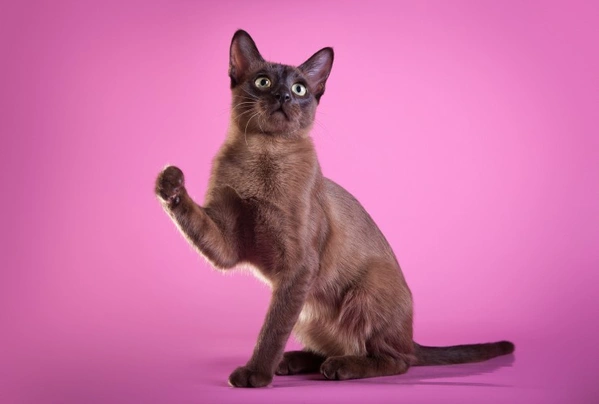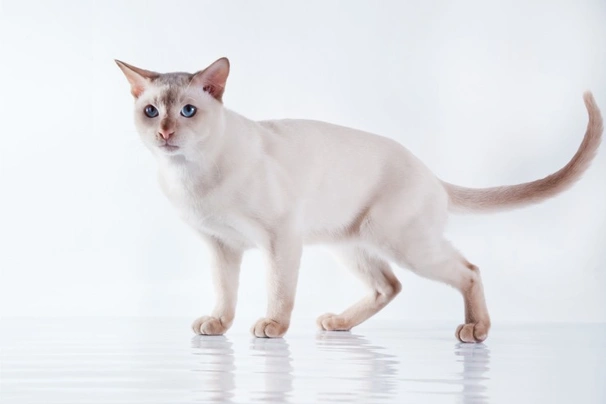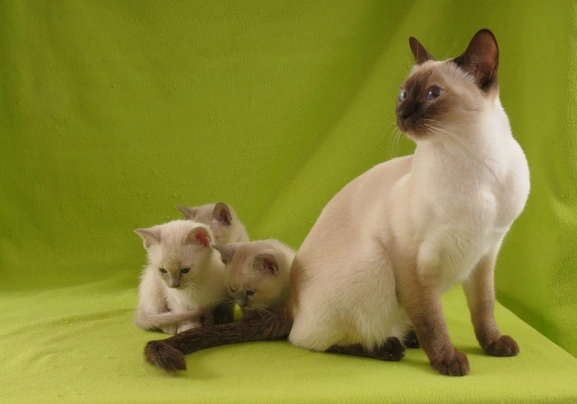Tonkinese
Introduction of the Tonkinese
The Tonkinese is a breed that's relatively new to the cat world having first been developed in the United States during the 1950s. The cats we see today are a cross between a Burmese and a Siamese which means they have inherited a few of their parent breeds traits and their good looks. They adore being around people and form exceptionally strong bonds with their owners which makes them perfect companions and family pets. Being highly intelligent it's a real pleasure to share a home with a Tonkinese because they make sure there is never a dull moment when they are around.
History of the Tonkinese
The Tonkinese is in fact thought to be one of the oldest breeds on the planet although it was not until 1880s that the breed was recreated. At the time they were known as the "Chocolate Siamese". Although many people believe the breed came about by crossing the Burmese with the Siamese it is thought that all three breeds are in fact unique in their own right and that they are genetic cousins. The difference being in their coat textures and colours as well as their eye colour.
They were first developed in the west in the late 1880s when a "chocolate royal Siamese cat" was imported to the States from Singapore. However it was not until the 1930s that Dr Joseph C Thompson decided to prove that a Tonkinese cat called Wong Mau owed her colouring to two specific genetic factors. He then established a breeding programme to create the Burmese. As such the foundation breed for the Burmese was a Tonkinese cat and it was proved that Wong Mau did indeed boast having the characteristics of two breeds of cat instead of just the one. As time passed a Tonkinese kitten would appear in Burmese and Siamese litters with one of the most famous being Casa Gatos Da Foong a cat that boasted a very complex pedigree which included the Burmese Siamese and Tonkinese.
During the 1950s Milar Greer crossed a Burmese with the Siamese and produced cats with a distinct intermediate coat colour and pattern. To begin with they were known as "Golden Siamese". However at the time not much interest was shown in the breed and these charming and attractive cats were totally forgotten when the breeder gave up. Luckily during the 1960s more interest was shown in these unusual cats which were then renamed "Tonkinese". A breed standard was drawn up and after this their popularity started to increase as more cats were exhibited at cat shows all over the country.
The breed was accepted by the majority of the international breed clubs over the following years. However it was not until 2002 that the mink coated Tonkinese was awarded Championship status by the GCCF in the UK. However the solid and pointed Tonkinese was only granted Championship status in 2015. Today more of these charming cats are being bred and registered thanks to the fact that Tonkinese cats boast being so attractive and because they are known to be intelligent affectionate and playful which makes sharing a home with one such a pleasure.
Appearance of the Tonkinese
The Tonkinese is an exceptionally attractive medium sized well-balanced looking cat that boasts an athletic lithe appearance and exceptional sparkling eyes. Their heads are a modified wedge that's slightly rounded being a little longer than it is wide. They have beautiful high cheekbones and quite blunt muzzles that are as long as they are wide. Cats have a slight whisker break which is gently curved and they have a slight stop found at eye level. When seen in profile the tip of a cat's chin is in line with the tip of their nose being on the same vertical plane. There's also a slight rise from a cat's nose stop to their forehead.
They have medium sized ears that boast oval tips being broader at the base and set as far on the side of a cat's head as they are on the top of it. The hair on their ears is close-lying and short so that leathers show through. Their eyes are open and almond shaped being slanted from the cheekbones to the outer edge of a cat's ears. The Tonkinese boasts having extremely brilliant coloured eyes.
They have medium length well-developed muscular svelte compact bodies that are extremely well proportioned. Their legs are slender long and nicely in proportion with the rest of a cat's body with their back legs being longer than their front ones. They have quite oval shaped paws with five toes on their front ones and only four on the back paws. Tails are moderately long and in proportion with the body tapering to the tip.
When it comes to their coat the Tonkinese boasts having a medium to short close lying coat that's extremely fine and silky to the touch and which always has a lovely sheen to it. The colour of a cat's body takes around 16 months to fully develop and it darkens as cats grow older. Point colours are found on a cat's mask ears feet and tail but this merges smoothly into their body colour. However in kittens their points are connected by tracings. The accepted breed colours are as follows:
- Natural mink
- Champagne mink
- Blue mink
- Platinum mink
- Natural solid
- Champagne solid
- Blue solid
- Platinum solid
- Natural point
- Champagne point
- Blue point
- Platinum point
Temperament of the Tonkinese
Like other breeds the Tonkinese likes a routine in their lives and doesn't particularly like it when this changes for any reason. They like to be fed at the same time of the day and don't appreciate it when furniture gets moved around the home which can stress them out. With this said they are known to be quite gregarious by nature and adore being around people. They also have a sense of humour and like to keep their owners entertained. They don't like to be left on their own for any length of time which means they are best suited to families where at least one person stays at home when everyone else is out of the house.
They are quite talkative by nature and will happily hold a long conversation with their owners whenever they can. They adore being able to explore the great outdoors but cats should only be allowed to roam outside if it is safe for them to do so. The good news is they adapt well to living as indoor pets as long as they are given enough stimulation and things to do to keep them occupied. They are often referred to as being more dog-like than other breeds with one of the favourite pass times being to follow an owner around from room to room so they can be with them and keep an eye on what they are doing.
Intelligence / Trainability of the Tonkinese
The Tonkinese is a highly intelligent cat and one that can be taught to do all sorts of tricks. They are very outgoing and confident which means a Tonkinese gets easily bored. They are also known to be a little stubborn but at the same time they are easily distracted especially if there's a game involved. They adore playing interactive games which includes thinks like "fetch" the toy. They also like to climb up to high vantage points so they can look down on the world below. Sharing a home with a Tonkinese means investing in lots of good quality toys and building safe high platforms for them to use whenever they want to.
Children and other
The Tonkinese with their outgoing affectionate personalities are a good choice for families where the children are that much older and who therefore know how to behave around cats. However care has to be taken when they are around very young children and any interaction should always be supervised by an adult to make sure things stay nice and calm. With this said younger children need to be taught how to behave around cats and when it's time to leave them alone.
They also get on well with dogs especially if they have grown up together in the same household. However care has to be taken when introducing a Tonkinese to dogs they don't already know just in case the dog does not get on with their feline counterparts. Although the Tonkinese is known to be social by nature which means they usually get on with everyone and this includes other pets it's always wiser to keep a close eye on any cat when they are around smaller pets particularly when they first meet each other just to be on the safe side.
Health of the Tonkinese
The average life expectancy of a Tonkinese is between 12 and 15 years when properly cared for and fed an appropriate good quality diet to suit their ages.
The Tonkinese is known to be a healthy breed and one that does not appear to be affected by any of the hereditary health issues that affect other breeds.
Caring for the Tonkinese
As with any other breed Tonkinese cats need to be groomed on a regular basis to make sure their coats and skin are kept in top condition. On top of this they need to be fed good quality food that meets all their nutritional needs throughout their lives which is especially true of kittens and older cats.
Grooming of the Tonkinese
The Tonkinese boasts having a short close lying coat and as such these charming cats are low maintenance on the grooming front. A weekly brush and wipe over with a chamois leather is all it takes to keep their coats in good condition with a nice sheen on it. Like other breeds they tend to shed the most in the Spring and then again in the Autumn when more frequent brushing is usually necessary to keep on top of things.
It's also important to check a cat's ears on a regular basis and to clean them when necessary. If too much wax is allowed to build up it can lead to a painful infection which can be hard to clear up. In short prevention is often easier than cure with ear infections. Cats often suffer from ear mites which can be a real problem which is why it's so important to check their ears on a regular basis.
Exercise of the Tonkinese
The Tonkinese boasts having a ton of energy and they thrive on being around people playing lots of interactive games with them when they are not cat napping that is. They adore being able to go outside so they can explore their environment and mark their territory. However cats should only be allowed to roam around in the great outdoors if it is safe for them to do so. Tonkinese adapt extremely well to being kept as indoor pets as long as they are given enough mental stimulation and things to do.
Cats kept as indoor pets need to have lots of places to hide when they want to bearing in mind that the Tonkinese loves to climb up high so they can look down on the world below from a favourite vantage point. They also need to have lots of places they can snuggle up for a snooze when the mood takes them because if there is one thing the Tonkinese really enjoys doing it’s taking a few cat naps throughout the day.
Feeding of the Tonkinese
If you get a Tonkinese kitten from a breeder they would give you a feeding schedule and it's important to stick to the same routine feeding the same kitten food to avoid any tummy upsets. You can change a kitten's diet but this needs to be done very gradually always making sure they don't develop any digestive upsets and if they do it's best to put them back on their original diet and to discuss things with the vet before attempting to change it again.
Older cats are not known to be fussy eaters but this does not mean they can be given a lower quality diet. It's best to feed a mature cat several times a day making sure it's good quality food that meets all their nutritional requirements which is especially important as cats get older. It's also essential to keep an eye on a cat's weight because if they start to put on too much it can have a serious impact on their overall health and wellbeing. Like all other breeds the Tonkinese needs access to fresh clean water at all times.
Tonkinese price
If you are looking to buy a Tonkinese you would need to pay anything from £300 to over £700 for a well-bred kitten. The cost of insuring a male 3-year-old Tonkinese in northern England would be £14.16 a month for basic cover but for a lifetime policy this would set you back £25.43 a month (quote as of October 2016). When insurance companies calculate a pet's premium they factor in several things which includes where you live in the UK a cat's age and whether or not they have been neutered or spayed among other things.
When it comes to food costs you need to buy the best quality food whether wet or dry making sure it suits the different stages of a cat’s life. This would set you back between £15 - £20 a month. On top of all of this you need to factor in veterinary costs if you want to share your home with a Tonkinese and this includes their initial vaccinations their annual boosters the cost of neutering or spaying a cat when the time is right and their yearly health checks all of which quickly adds up to over £600 a year.
As a rough guide the average cost to keep and care for a Tonkinese would be between £40 to £60 a month depending on the level of insurance cover you opt to buy for your cat but this does not include the initial cost of buying a well-bred kitten.

Pedigree registered Tonkinese kittens
£850
Beautiful Female cats 18 Months £20
£50



